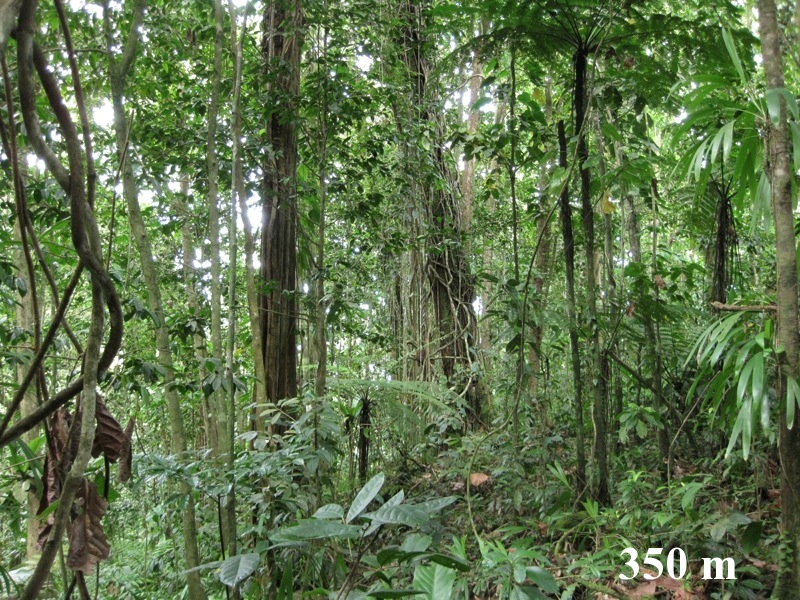We, Lolita
and Lisa, conducted complementary studies on the eastern side of Piton des Neiges in the National Park
of La Réunion. Our hypotheses were built up on the
data set from their first inventory in 2008. In the frame of our two
master studies we, both, try to find explanations about the distribution of the
plant species they found and therefore visited the plots together. However, our thesis are based on two
different perspectives in ecology.
Lolita focuses on the large scale distribution of the three major plant groups
(Bryophytes, Pteridophytes and Angiosperms) and investigates the effect of
water use efficiency on their altitudinal distribution in La Réunion for her master at the University of Zürich.
Lisa is doing
her master thesis (Paris 6) on ecological factors affecting the vertical distribution of
corticolous (=bark living organisms) bryophytes along an elevational gradient. The hypothesis is that
bryophytes have specific microhabitat determined by various abiotic factors (temperature,
interception of sunlight and exposure of the area) and biotic (bark rugosity,
tree species).
We stayed at Gite de la
Bélouve few nights and at La Caverne Dufour for a couple of nights. Also, we
climbed up the Piton des Neiges (3070 m) for our work as the highest plot is at
2950 m!
FIELDWORK
Lolita Ammann:
Liverworts, mosses, ferns and angiosperms have their diversity maxima at different elevations. The older the stem group, the higher lies its diversity maximum on the elevational gradient. In this study I test how much this pattern is determined by water use efficiency by making up three hypothesis:
-Water use efficiency should become higher in lower elevations considering the decrease in water availability towards lower elevations,
- Comparing
humid and arid sides of mountains, the decrease of overall diversity on the
arid side is more pronounced for groups with lower water use efficiency,
- Comparing humid and arid sides of mountains, diversity patterns of the major plant groups are shifted upwards on the arid side because of higher cloud condensation levels and the increasing importance of low temperatures in determining environmental humidity.
 |
| On the sentier de la Rivière, Bélouve forest |
- Comparing humid and arid sides of mountains, diversity patterns of the major plant groups are shifted upwards on the arid side because of higher cloud condensation levels and the increasing importance of low temperatures in determining environmental humidity.
Three approaches/methodologies should help me to assess the questions: for carbon isotope ratio (δ13C), samples of the 5 most representatives of the three stem groups are collected for both terricolous and epiphytic habitats, LICOR 6400 (gas
exchange measurements, i.e., uptake of CO2 and release of water) these tests will
be conducted in controlled greenhouse conditions, so collected plants needed to be
transferred alive to Zürich, and finally comparison of the diversity pattern of
fern and angiosperm species between the western and eastern transect.
Lisa Margot Couet:
We are currently aware that landscape
feature creates microclimate. Therefore, we can suppose that bryophytes, being
small organisms and living in a wide range of substrat have particular
microhabitats. As any plants, bryophyte species have different light and
temperature requirements. My work focuses on factors affecting the corticolous
microhabitats for bryophytes.
The hypothesis is that there is a smaller scale
distribution and assemblage of species along the phorophyte.
 |
| Lisa measuring the temperature of the moss colony |
I collected data for
the following species: Mastigophora diclados (Brid.
ex F.Weber) Nees), Pyrrhobryum spiniforme (Hedw.) Mitt.,
Dicranoloma
billardierei (Brid.) Paris, Pleurozia gigantea (F.
Weber) Lindb., Holomitrium borbonicum Besch., Herbertus dicranus (Taylor ex Gottsche, Lindenb. & Nees) Trevis., Leucophanes angustifolium (Renauld & Cardot ) and the two gender
Bazzania and Radula.
 |
| luxmeter |
Describing ecological
niches of corticolous bryophytes is a particular matter as some are referred as
biological indicators. Knowing if a species is a generalist or a specialist across
ecosystem can help to investigate on the impact of climate change at different scales. Also, as a complementary on bryophyte niches, I investigated
the assemblage of a few common species and their distribution along the elevational gradient.
We had a great time
exploring the montane tropical forests. Local botanists and ecologists who
are involved in project within the park came to give us a hand in the field for
the collection and the identification of plants. Furthermore, we were part of
the team to set up the new transect in the Western side, at La Forêt des Makes, where sensors of temperature and relative humidity were set up every 200 m from 1150 to 2350 m.
Many thanks to Jacques, Pierre, Olivier, Dominique S, Dominique H and in particularly
Claudine Ah-Peng who take us in the field and take care of the organization of
the field work.
 |
| Lolita, Lisa and Dominique H, Takamaka viewpoint |
 |
|
From left to right, Lisa, Claudine, Jacques and Lolita, 7th of June 2013, Bélouve forest
|



























